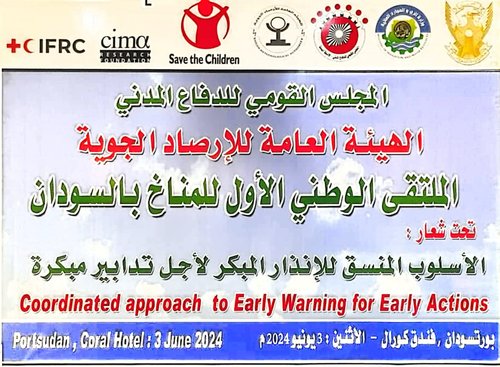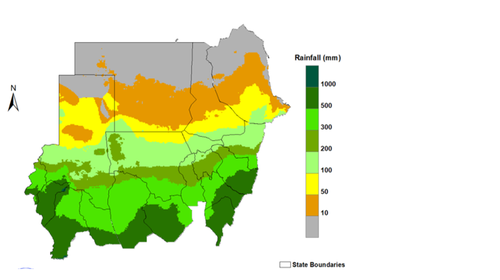Sudan Climate Outlook Forum (SUNCOF1): Necessary for Anticipatory Action and Resilience amidst Climate risk, Conflict and Displacement

On June 3, 2024, Port Sudan’s Coral Hotel hosted Sudan Climate Outlook Forum (SUNCOF1), a platform that brought together all key national climate stakeholders across all sectors: decision-makers, climate scientists and users. This provided a unique opportunity for the sectors to contribute to the production of climate information tailored to their specific needs.
Sudan Meteorological Authority presented the seasonal rainfall and temperature forecast for Sudan from June to September 2024, which indicates an increased chance of rainfall above climatological averages in most states, with varying percentages.

The average temperatures for the June-September 2024 season are anticipated to exceed climatological averages. Notably, surface temperatures are expected to soar above average by a significant margin. This widespread temperature anomaly is expected to have significant implications for various sectors, including agriculture, health, and infrastructure.

Read the Seasonal Forecast report for more information on the seasonal forecast,Report:Seasonal Rainfall and Temperature Forecast for JJAS 2024
On June 3, 2024, Port Sudan’s Coral Hotel hosted Sudan Climate Outlook Forum (SUNCOF1), a platform that brought together all key national climate stakeholders across all sectors: decision-makers, climate scientists and users. This provided a unique opportunity for the sectors to contribute to the production of climate information tailored to their specific needs.
Sudan Meteorological Authority presented the seasonal rainfall and temperature forecast for Sudan from June to September 2024, which indicates an increased chance of rainfall above climatological averages in most states, with varying percentages.

Climatic Averages of Rainfall for Different Regions of Sudan
The average temperatures for the June-September 2024 season are anticipated to exceed climatological averages. Notably, surface temperatures are expected to soar above average by a significant margin. This widespread temperature anomaly is expected to have significant implications for various sectors, including agriculture, health, and infrastructure.

Read the Seasonal Forecast report for more information on the seasonal forecast Report:Seasonal Rainfall and Temperature Forecast for JJAS 2024
Climate Services Co-production
The stakeholders had an opportunity to discuss the seasonal rainfall and temperature forecasts (June-September) and the development of warnings to ensure climate-smart decisions. The importance of early warning and early action cannot be overstated, particularly in fragile regions and states affected by conflict, where over 9.1 million individuals are internally displaced due to ongoing conflict.
The implications of rain and temperature forecasts for the season (June-September 2024) were discussed, along with response strategies for different sectors. The significance of reflecting seasonal forecasts on various sectors lies in understanding their impact, a concept known as impact-based forecasting, which has become a global approach. By knowing the effects of expected weather conditions during the season, decision-makers can respond early and plan effectively to mitigate risks and disasters.
Given the existing vulnerability due to displacement, these forecasts are vital for planning and preparedness, enabling decision-makers to tailor responses to the heightened risk of flooding and other rainfall-related challenges.
Collaboration for improved Multi Hazard Early Warning Humanitarian Action
The forum was significantly supported by international partners such as CIMA Foundation, IFRC, Red Cross Sudan, and Save the Children, which are actively involved in enhancing the early warning systems in collaboration with Sudan's state actors including National Civil Council for Civil Defense (NCCD), Ministry of Water Resources and Irrigation (MoWR), Humanitarian ( HAC) , Ministry of Environment and others.
The Humanitarian Actors recognized the critical importance of the climate information shared at SUNCOF1 for their ongoing humanitarian efforts in Sudan. This information directly informs their strategies for emergency response, preparedness, and resilience-building among the most affected communities.By leveraging detailed seasonal forecasts, they are better positioned to execute timely and effective actions that mitigate the adverse impacts of climate variability on vulnerable populations, especially children.
Looking ahead
The discussions at SUNCOF1 underlined the necessity of anticipatory actions in the context of the predicted heavy rainfall. With the advanced notice provided by the seasonal forecasts, Sudanese authorities and partnering NGOs can mobilize resources, strengthen community resilience, and implement disaster risk reduction strategies more effectively.
SUNCOF1 has set a critical foundation for future climate resilience efforts in Sudan. The collaborative environment of the forum facilitated a proactive exchange between scientists, policymakers, and humanitarian actors, all united in their goal to harness climate information for the betterment of Sudanese society. As Sudan navigates through its complex socio-political landscape, the insights from SUNCOF1 will undoubtedly play a crucial role in safeguarding vulnerable communities against the unpredictable whims of climate change.

